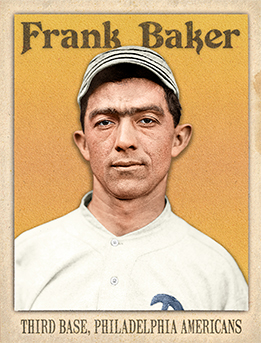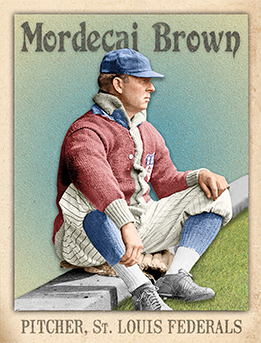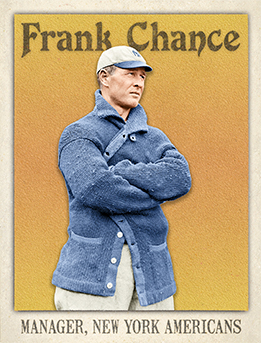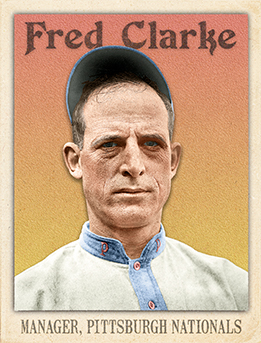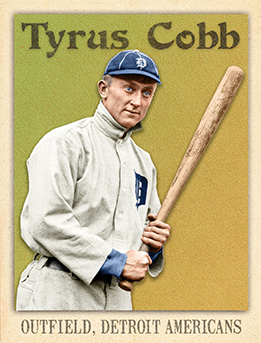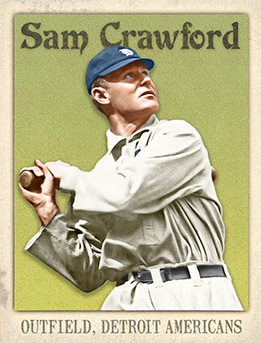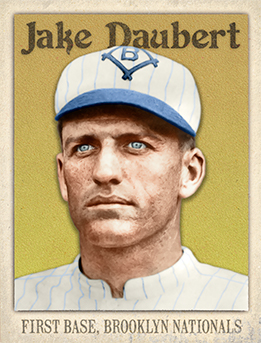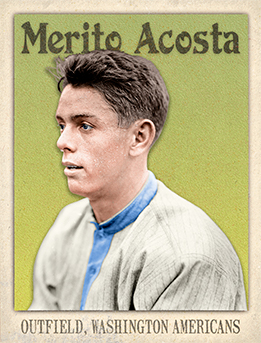
- Series: Diamond Heads '15
- City: Washington, D.C.
- Team: Senators
- League: American League
- Hall: Cuban Baseball Hall of Fame
Baldomero Pedro Acosta Fernandez (1896-1963) began playing winter ball in his native Cuba in 1913 and debuted the same year with the Washington Senators as one of the first of his countrymen to play in MLB. As a sixteen-year-old that spring, The Sporting Life had heralded the young Cuban as “a second Ty Cobb.” That lofty promise went unfilled in American ball, as Merito played part time in the outfield, only making 200+ plate appearances twice with Washington. He finished his major league career in 1918 with the Philadelphia Athletics where he logged his best year at bat, hitting .302. Acosta was part of two remarkable feats in his career: in 1915 he and Chick Gandil walked, were sacrificed along and Gandil scored on a sac fly to record a rare run without an official at-bat in the inning. In 1919 with Havana, the fleet-footed center fielder accomplished an unassisted triple-play, racing to second after the catch to tag the bag and the runner coming from first. Acosta found a new home with the Louisville Colonels of the minor league American Association from 1919-28.
- In 1922/23 Acosta was named manager of a new Cuban franchise in Marianao and led them to the championship
- Elected to Cuban Baseball Hall of Fame: 1955
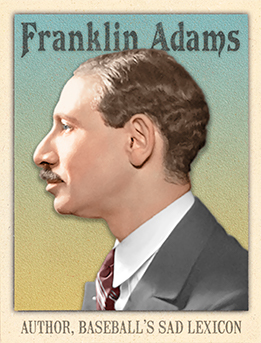
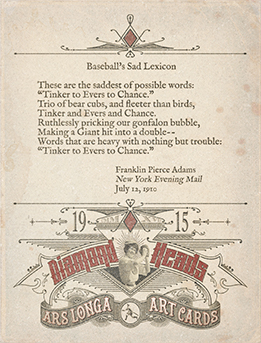
- Series: Diamond Heads '15
Franklin Pierce Adams (1881-1960) was known to his readers as F.P.A. His column “The Conning Tower” was a literary staple in the diet of New York’s literati from 1914 until 1941. Adams had come east from his native Chicago ten years prior as a sportswriter/humorist, signing on with the Evening Mail. His column, “Always in Good Humor” mixed sports items with reader contributions. His popularity was a mere hint at the impact he would have after moving to the Tribune and launching the Conning Tower. Adams’ column introduced New York and the world to many of the great writers and humorists of his day: Robert Benchley, Edna Ferber, Dorothy Parker, James Thurber and many others. F.P.A earned his stripes literally and figuratively after enlisting in WWI. He wrote for Harold Ross, editor of the Stars and Stripes and established a reputation as a wordsmith and master of the English language.
Adams became a charter member of one of America’s greatest literary salons, a daily luncheon at the Algonquin Hotel in Manhattan. The circle of playwrights, journalists, poets, editors and show business celebrities came to be known as the Round Table and was a fountain of wit and word-play that spread coast to coast for a decade, ending only when the nation plunged into Depression. It must have been the height of irony to such a leading-light in America’s literary scene that Adams’ fame lived on long past his demise, not for his incisive wit, his eye for talent, his hobnobbing with the cream of society but for an eight-line bit of doggerel he had tossed off for a column on July 12, 1910. Originally titled “That Double Play Again,” it appeared first in the NY Evening Mail on the eve of a Cubs-Giants series. As F.P.A. was en route to the Polo Grounds, he dashed off the piece to meet his editor’s demand for filler for that night’s column. He thought it forgettable and so did his editor. On the 15th the Chicago Daily Tribune reprinted the lament as “Gotham’s Woe.” But on the 18th, the Evening Mail ran it again, this time as “Baseball’s Sad Lexicon” and history was made. The ode took on a life of its own and immortalized the Cubbies’ infield, probably securing their admission to Cooperstown:
Baseball's Sad Lexicon
These are the saddest of possible words:
“Tinker to Evers to Chance.”
Trio of bear cubs, and fleeter than birds,
Tinker and Evers and Chance.
Ruthlessly pricking our gonfalon bubble
Making a Giant hit into a double
Words that are heavy with nothing but trouble:
“Tinker to Evers to Chance.”
- This card is not included in the 100-card Diamond Heads '15 base set.
- This card is one of the rewards you receive for completing the Ars Longa Clubhouse Challenge: Tinker to Evers to Chance
- This card is exclusive to that challenge, is gifted freely to winners of the challenge, and is neither bartered nor sold otherwise by Ars Longa.
- This is one of two such Diamond Heads '15 Clubhouse Challenge reward cards. The other is Frank "Wildfire" Schulte.
- Series: Diamond Heads '15
- City: Philadelphia
- Team: Phillies
- League: National League
- Hall: National Baseball Hall of Fame
Grover Cleveland Alexander (1887-1950) earned his plaque in the Hall of Fame on the strength of his strong right arm & an indomitable spirit. The battered WWI vet fought German mustard gas, epilepsy-inducing artillery, PTSD-induced alcoholism and opposing hitters, all with honor and distinction. It is impossible to know the record he would have achieved but for the interruption of war.
- Led the NL in ERA 1915, ‘16, ‘17, ‘19, and ‘20. Led GIs into battle in ‘18
- Said of his induction into the HOF: “the greatest treat and one of the biggest thrills” of his life
- Elected to Hall of Fame: 1938
- Series: Diamond Heads '15
- City: Philadelphia
- Team: Athletics (AL)
- League: American League
- Hall: National Baseball Hall of Fame
John Franklin Baker (1886-1963) was released by his minor league mgr who declared he “could not hit.” Connie Mack needed a 3rd baseman and gave Baker a try at the end of the 1908 season. Baker played 13 years exclusively at 3rd. He wielded his 52-oz bat like no other in the dead ball era.
- Led the AL in HRs 4 straight years for the Athletics
- Helped Connie Mack’s team to 3 Series victories, closed his career with Babe Ruth’s Yankees
- Elected to Hall of Fame: 1955
- Series: Diamond Heads '15
- City: Philadelphia
- Team: Athletics (AL)
- League: American League
- Hall: National Baseball Hall of Fame
Charles Albert Bender (1884-1954) won 212 games en route to a Hall of Fame career. He began life amid the abject poverty of a Minnesota reservation, was mentored by Pop Warner at the Carlisle Indian School and hit the majors with a bang for the Athletics in 1903. “Albert” as Connie Mack called him, beat future Hall members Cy Young and Clark Griffith compiling 17 wins in his rookie season. He led the league 3x in win percentage but was at his best under pressure. In 5 World Series, Bender won 6 games with a 2.44 ERA and completed 9 of his 10 starts.
- Connie Mack said that of all his players he would most trust Bender to win in the clutch
- Admired for his brilliance, Ty Cobb dubbed him the most intelligent pitcher he ever faced
- Elected to Hall of Fame: 1953
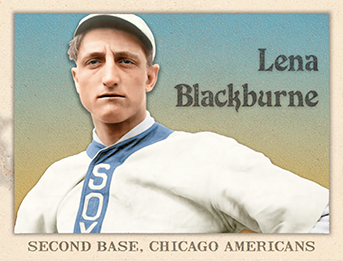
- Series: Diamond Heads '15
- City: Chicago
- Team: White Sox
- League: American League
Russell Aubrey Blackburne (1886-1968) was no great shakes as a player and had a sub-.500 career as a manager. Not many with a lifetime .214 average get mentioned at Cooperstown. But Lena had a bulldog spirit and a zeal to improve one key aspect of baseball: the sheen on the balls themselves. Until Blackburne’s “Rubbing Mud,” balls were doctored with tobacco juice, Shinola, and whatever the local swamps provided, all in an attempt to take some of the manufacturer’s shine off the spheres. Lena found a solution that still serves the game today. True to his discoverer’s spirit, he kept secret the source of the clay from which he made the rubbing compound. It was believed to be a spot on the Delaware River near his home. Blackburne had played for the White Sox, Reds, Braves, and Phillies before coaching and managing for the Sox, Browns and Athletics. He was enough of an AL-partisan to restrict use of his wonder-mud to the American League until the mid-1950s when the NL at last could partake.
- No other compound improved the grip on the ball without damage to the horsehide
- No one has gotten rich from the Mud. Team’s can get by with one 32-oz container per season at a cost of about $60. The current vendor of Blackburne’s concoction has to work full-time to support his family
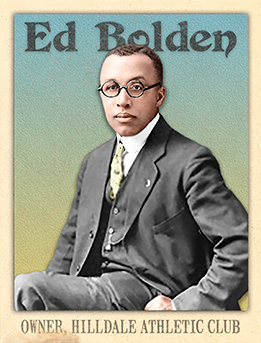
- Series: Diamond Heads '15
- City: Darby
- Team: Hilldale Athletic Club
- League: Independent
Edward Bolden (1881-1950) was one of the most successful entrepreneurs in black baseball in the early 20th century. Though it sounds dissonant to the contemporary ear, Bolden proudly declared himself a “race man” and boldly promoted his club as one owned and operated by other race men. This was in opposition to overtures and intimidations of white impresarios seeking to horn in on the growing popularity of negro ball in the 1920s. Bolden was always a keen recruiter of talent and his reputation for black-ownership attracted some of the best to his teams including Louis Santop, Smoky Joe Williams and Dick Lundy. Ed cut his showman's teeth with the Hilldale Club of Darby PA, bringing solid management and a zeal for rectitude on and off the field. He banned alcohol and demanded decorum from his players. He even enforced discipline among the fans and brought in security when needed. Conflicts with Rube Foster over accusations of poaching by Bolden, coupled with high operating costs especially for travel, led Bolden to leave the Negro National League for the Eastern Colored League in 1922. The two superstars of black league management faced off in the first Colored World Series in 1924 with Foster's KC Monarchs triumphant. Bolden's squad got revenge the following year.
- Black teams always ran on a shoestring and as the economy worsened in the late '20s and plunged in the Depression, Bolden left the game temporarily.
- He returned to lead clubs through the war years and the cusp of integrated ball he earnestly desired to see. He was the last of the breed of early black ownership upon his death in 1950
- Series: Diamond Heads '15
- City: Chicago
- Team: Cubs
- League: National League
- Hall: National Baseball Hall of Fame
Roger Bresnahan (1879-1944) played every position but came into his own as a lead-off-hitting catcher and battery mate to Christy Mathewson for John McGraw’s Giants. Innovation took guts in a rowdy era and he had the fortitude to introduce shin guards, batting helmets and padded masks over the protests of other clubs and the pelting of irate fans (who didn’t have to catch Mathewson.)
- Batted .350 in 1903, trailing only Honus Wagner’s .355 and Fred Clarke’s .351
- Elected to Hall of Fame the year after his death: 1945
- Series: Diamond Heads '15
- City: St. Louis
- Team: Terriers
- League: Federal League
- Hall: National Baseball Hall of Fame
Mordecai Peter Centennial Brown (1876-1948) gained the Hall of Fame on the strength of a wicked curve, enhanced by childhood accidents that cost him parts of two fingers on his “twirling” hand. He won 20+ for the Cubs six times from 1904-12 with two world championships.
- Career record of 239-130 and the 3rd best ERA of all time: 2.06
- Had legendary duels with Giants’ Christy Mathewson, and went 13-11 against him
- His 2.06 ERA is best ever by a pitcher with more than 200 wins
- Elected to Hall of Fame: 1949
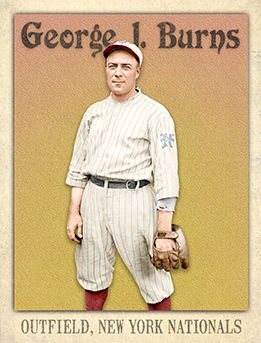
- Series: Diamond Heads '15
- City: New York
- Team: Giants
- League: National League
George Joseph Burns (1889-1966) was dubbed by his teammates “Silent George” for his reserved, soft-spoken manner. He might as well have been named “Anonymous George” as one of the greatest outfielders of his generation of whom few remember today. He retired holding records for leading the National League in runs scored five times, a Giants' club single-season record for steals (62) that still stands, and top-ten ranking in games played and games in the outfield in MLB. The Utica native debuted with McGraw's crew in 1911 and George quickly found a home in left at the Polo Grounds, mastering its odd angles and even conquering the dazzling afternoon glares, prompting scribes to dub the area Burnsville. He was one of the first to don sunglasses and his mates later described him as “the 'greatest sun fielder' in the history of the game.” Only Rogers Hornsby exceeded George's total bases in 1917 and it wasn't till Willie Mays 53 years later in 1972 that his career stolen base record for the Giants would be eclipsed. His last hurrah in NY was the 1921 Series. The team hadn't won in October since 1905 and George hadn't performed well in his previous attempts at post-season glory. But '21 proved triumphant for Burns and his team as they beat the Yankees in the first Series between teams sharing the same home field. Babe Ruth had been phenomenal in the regular season but was hurt during the post-season and George got to wear the laurel wreath.
- A renowned amateur boxer and wrestler, the diminutive Burns never backed down from invitations to grapple with his much more physically formidable teammate Jim Thorpe
- Growing up in his father's pool hall, Burns was a world-class pool player, but teammates wouldn't play with him unless he agreed to play left-handed
- McGraw traded Burns to the Reds two months after the '21 World Series for Heinie Groh, but the speedy Burns wasn't through. He set an NL record with his 28th steal of home in 1922
- In fifteen ML seasons, Burns' 2,077 hits produced a .287 career average and only Musial and Hornsby equaled his feat of leading the NL five-times in runs record
- Series: Diamond Heads '15
- City: Pittsburgh
- Team: Pirates
- League: National League
- Hall: National Baseball Hall of Fame
Max George Carey (1890-1976) was “harder to stop than a run in a silk stocking” per Joe Williams. A superb center fielder with a fine lifetime BA of .285, it was on the base paths that he made his mark with the Pirates and Robins. Saving his best for (nearly) the last, Carey led Pittsburgh to the pennant with a .343 BA, and to the title with a .458 Series average in 1925.
- In 1922 was successful in steals 51 of 53 attempts and led the NL ten times
- Stole home 33 times, second only to Ty Cobb’s 50
- Elected to Hall of Fame: 1961
- Series: Diamond Heads '15
- City: New York
- Team: Yankees
- League: American League
- Hall: National Baseball Hall of Fame
Frank Leroy Chance (1876-1924) was a tenacious and fiercely competitive MLB player-manager for the Cubs and Yankees and manager of the Red Sox. John L. Sullivan called him the “greatest amateur brawler of all time.” Chance brought that pugilistic spirit to the diamond, giving unruly fans and players as good as he got.
- Joined the fraternity of the immortals in Cooperstown with the teammates with whom he is forever linked: Johnny Evers and Joe Tinker
- Cubs’ owner gave Chance a 10% stake in the club as reward for stealing home from 2nd in a tied game
- Elected to Hall of Fame: 1946

- Series: Diamond Heads '15
- City: Cleveland
- Team: Naps
- League: American League
Raymond Johnson Chapman (1891-1920) is the only big leaguer to be killed by a baseball. He was beaned on a late Cleveland afternoon, probably blinded by the setting sun and the earth-colored ball so carefully doctored by the pitchers of that era. Indeed, MLB responded to Chapman’s tragic death with rules against spitters and all manner of doctored balls. Chapman had played only for Cleveland, anchoring the infield at short and setting some team and league records that still stand. And he was truly loved, a cheerful bundle of energy befriended by the greats of his day (Al Jolson, Will Rogers) and by the nearly friendless Ty Cobb. The newlywed Chapman had wanted to retire before the 1920 season but stayed on out of loyalty to new manager Tris Speaker, his best man.
- Averaging a solid .278 for his nine year career, Chapman was hitting .304 at his death
- Led the AL in walks and runs (84 each) in the war-shortened ’18 season
- Still ranks sixth all-time in sacrifices
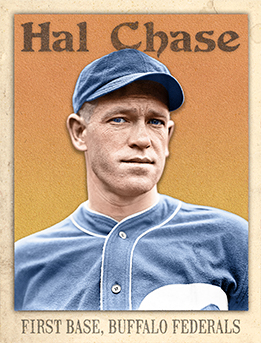
- Series: Diamond Heads '15
- City: Buffalo
- Team: Blues (FL)
- League: Federal League
Harold Homer Chase (1883-1947) may have been among the best first-basemen ever, but his “errors” place him as mediocre at best. His own words are his epitaph: “I am an outcast, and I haven’t a good name. I’m the loser, just like all gamblers are.” A star for the NY Highlanders for the first nine years of the franchise, admired by peers such as Babe Ruth and Walter Johnson, Chase even went on to out-poll dozens of later entrants into the Hall of Fame. Such was his prowess at first and plate. But his compulsion to wager, and the ease of access to illicit betting (the bookies were in the front row) consigned this great player to ignominy.
- Chase’s spiral from NY idol to deportee from Mexico evidenced his inability to stay straight in an era when the crooked path was wide and inviting
- Chase was banned from baseball for life by commissioner Kennesaw Mountain Landis in 1922 for his (unsubstantiated) role in the 1919 Black Sox scandal
- Despite the controversy that consumed his career, Chase received more HOF votes in 1936 than 18 future HOFers, and more votes in 1937 than 32 future HOFers, but he never appeared on the ballot again
- Series: Diamond Heads '15
- City: Chicago
- Team: White Sox
- League: American League
Edward Victor “Knuckles” Cicotte (1884-1969) won 208 games and a World Series with the White Sox in 1917. The Sporting News said in 1918 that “Perhaps no pitcher in the world has such a varied assortment of wares….” But it was Eddie’s first pitch of the 1919 Series that plunked Morrie Rath and signaled the fix was in. No one was ever convicted of the infamous Black Sox scandal but Cicotte, with seven teammates, never played ML ball after his tearful confession following the ’20 season.
- Cicotte, Shoeless Joe, and other banned Sox players went on to barnstorm under false names
- His mastery of the knuckleball led to a transformation of his career. His control improved to the point of walking only 89 in 572 innings in 1918/19 combined.
- Series: Diamond Heads '15
- City: Pittsburgh
- Team: Pirates
- League: National League
- Hall: National Baseball Hall of Fame
Fred Clifford Clarke (1872-1960) broke into MLB in a big way, going 5 for 5 in his 1st game (never bettered.) This Hall-of-Famer starred with the Pirates along with Honus Wagner and Vic Willis, winning 4 of the 9 titles held by the Pittsburgh franchise. Was player-mgr most of his career.
- Hit over .300 eleven times, his .390 in ’97 was bested only by Wee Willie Keeler
- Honored at Cooperstown as the “first of the successful ‘boy managers’” at age 24
- Elected to Hall of Fame: 1945
- Series: Diamond Heads '15
- City: Detroit
- Team: Tigers
- League: American League
- Hall: National Baseball Hall of Fame
Tyrus Raymond Cobb (1886-1961) swept over the baseball landscape like a tidal wave. He lived by a fierce code that drove him to greatness and others to distraction. At the end, his own words could be his epitaph: “But I beat the bastards and left them in the ditch.”
- Cobb never won a World Series and performed with mediocrity in his only three tries
- No one of his era came close to the impact, for good or ill, made by this snarling Tiger
- Elected to Hall of Fame: 1936
- Series: Diamond Heads '15
- City: Philadelphia
- Team: Athletics (AL)
- League: American League
- Hall: National Baseball Hall of Fame
Edward Trowbridge Collins Sr. (1887-1951) was sold by Connie Mack to the White Sox in 1915 for the amazing sum of $50,000. His salary put him behind only Cobb and Speaker. He left the “$100,000 infield” of the Athletics for what would become the most notorious team in MLB history. He never believed the rumored “fix” for the Sox in 1919 and survived the scandal to lead the team in its aftermath.
- Only man to play for 2 teams for at least 12 yrs each
- Spent 15 yrs as GM for the Red Sox under his friend Tom Yawkey
- Elected to Hall of Fame: 1939
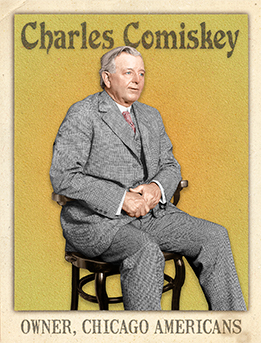
- Series: Diamond Heads '15
- City: Chicago
- Team: White Sox
- League: American League
- Hall: National Baseball Hall of Fame
Charles Albert Comiskey (1859-1931) rose from decent first-baseman to become one of the foremost managers and owners of baseball’s early decades. “The Old Roman’s” leadership skills emerged with his first team, the newly-minted St. Louis Browns whom he piloted to four pennants. He would go on to compile an outstanding 840-541 record. His .608 winning percentage is third-highest behind Joe McCarthy and Jim Mutrie. “Commy” parlayed his ownership of the Western Association’s Dubuque Rabbits into a franchise in the American League which he helped found in 1901. He built the White Sox stadium in 1910 which would bear his name for the next 81 years and presided for the next decade over one of the most talented and troubled teams in history. While many dismiss the charge that it was Comiskey’s penurious ways that “drove” his 1919 squad to infamy, there is no doubt he was a cheapskate of the first order. He underpaid, over-promised and reneged with abandon, epitomizing the arrogance of the reserve-clause era.
- Charles is credited with revolutionizing play at first-base, innovating play off the bag
- Owned the Chicago White Sox from 1901-1931, winning two World Series
- Elected to Hall of Fame: 1939
- Series: Diamond Heads '15
- League: American League
- Hall: National Baseball Hall of Fame
Thomas Henry Connolly (1870-1961) was a young English immigrant who became so fascinated by the strange game of baseball that he resolved to learn as much as he could about it. He devoured the rule book, began umpiring in Massachusetts and was discovered by a big league ump. So began a half-century career ending with election to the Hall of Fame as one of the first two officials so honored (with Bill Klem).
- Found his niche in the American League, officiating its first game on April 24, 1901
- From 1931 to 1954 was AL supervisor of umpires, assuring integrity and consistency in the game he knew as well as any man
- Elected to Hall of Fame: 1953

- Series: Diamond Heads '15
- City: Philadelphia
- Team: Phillies
- League: National League
Clifford Carlton Cravath (1881-1963) was the “home-run king of baseball” before being deposed by the Babe. His nickname derived from the seagull (gaviota in Spanish) he supposedly killed in flight during a PCL game for the Angels. Cravath labored in the obscurity of West Coast ball for 5 years before getting the call to Boston in 1908. His lack of speed offset his batting strength and he was sold to the White Sox that season and bounced back into the minors until he caught on at age 31 with the Phillies, becoming the leading power hitter of the Deadball Era. Led the Phils to their first pennant in 1915 and led the NL in HRs six times.
- Ruth broke Cravath’s career HR record in 1921
- In the ’15 Series, his manager inexplicably gave him the bunt sign with the bases loaded and no outs, leading to a double-play grounder to the pitcher
- Said to have caused a rule change by intercepting the ball in a rundown, hurling it into the stands, and scoring. Baseball decided to stop allowing that
- Series: Diamond Heads '15
- City: Detroit
- Team: Tigers
- League: American League
- Hall: National Baseball Hall of Fame
Samuel Earl Crawford (1880-1968) needed a couple more weeks among his 19 ML seasons to reach 3000 hits, finishing with 2961 and the all-time record for triples. “Wahoo Sam” teamed with Ty Cobb for 3 straight Series appearances ‘07-09. Neither did well or won a title. Nevertheless, the renowned manager who made Babe Ruth an outfielder said there was never a better hitter than Crawford. This Nebraska farm kid was considered the strongest hitter of his day and consistently ranked in the top 10 in slugging.
- Playing in the big Deadball Era parks, speedy Crawford set the record for inside-the-park HRs
- Debuting with Cincinnati in 1899, Crawford hit .307 as the youngest player in the majors
- A model of moderation, he rarely struck out, walked or reacted to teammate Cobb’s tirades
- Elected to Hall of Fame: 1957
- Series: Diamond Heads '15
- City: Brooklyn
- Team: Robins
- League: National League
Jacob Ellsworth Daubert (1884-1924) is considered by some the best first-baseman NOT in the Hall. His fielding was never below .989, he led the NL in batting 1913 & ’14, and was MVP in ’13. Seven times from 1911-19 he was named to Baseball Magazine’s All-America team. Popular with players and fans, his union activity alienated management.
- Charles Ebbetts sent him from Brooklyn to the Reds in 1919 following a salary dispute
- Became ill and died during his final road trip with the Reds in 1924
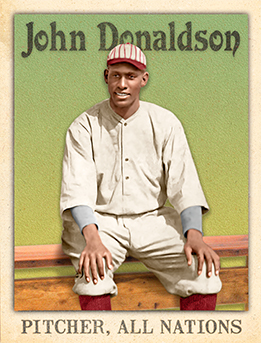
- Series: Diamond Heads '15
- Team: All Nations
- League: Independent
John Wesley Donaldson (1891-1970) “was the most amazing pitcher I ever saw” said J. L. Wilkinson, who had seen them all: Cubans, Blacks, Whites and the best female players of the early 20th century. Wilkinson's All Nations team was a famed forbear of the Negro Leagues of which he was a founder. He told Satchel Paige that, had Donaldson been available to play for their Kansas City Monarchs, Paige would have been behind John in the rotation. Research has documented as many as 399 wins in Donaldson's long career in black baseball; a career that would have been quite different had he heeded John McGraw's plea to adopt a Cuban persona, renounce his family ties and come play in the major leagues. McGraw later said he'd have paid $50,000 for the left-hander but for the color barrier. But Donaldson was a man of integrity and dignity. He wouldn't stoop to denying his heritage and thus remained in the “bushes” as modern baseball unfolded without him on the mounds that he deserved. Amateur historian Peter Gorton has made Donaldson his occupation, gathering records from libraries and news files around the country. Published box scores reveal games of phenomenal strikeout performances with the highest being 31 in an 18-inning game. John was just too good for the caliber of players he was able to face.
- Donaldson first pitched for clubs in Missouri before touring with the barnstorming Tennessee Rats and then the All Nations. His 30-year career ended in 1949, two years after Jackie Robinson debuted in Brooklyn
- 4,915 strikeouts have been documented for Donaldson. Remarkably, this total does not include the strikeouts from more than 150 games in which Donaldson pitched, but for which statistical data is lacking
- Research shows that Donaldson compiled a 1.37 ERA over his 30 year career, during which he also threw 13 no hitters and one perfect game.
- Donaldson had two, 30-k games; eleven, 25+ K games; thirty, 20+ K games
- Despite never playing in MLB, Donaldson did become the first full-time black scout in major league history. He scouted for the Chicago White Sox from 1949 into the 1950s
- Of Donaldson, John McGraw said, “I think he is the greatest I have ever seen.”
- J.L. Wilkinson credits Donaldson with suggesting the name “Monarchs” for Wilkinson’s pioneering Negro League team from Kansas City
- In 2006 the special HOF committee charged with evaluating pre-Negro League talent declined to include Donaldson
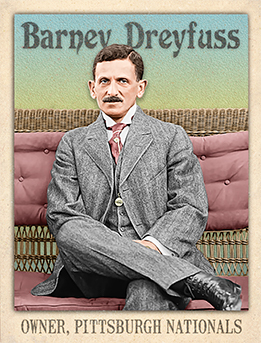
- Series: Diamond Heads '15
- City: Pittsburgh
- Team: Pirates
- League: National League
- Hall: National Baseball Hall of Fame
Bernhard Dreyfuss (1865-1932) embodied the American Dream. An immigrant Jew escaping Prussian army service, he arrived in the USA with little money and a job promise from relatives in a Kentucky distillery. He learned the language and fell in love with the national game, gradually building a stake in the local Louisville Colonels franchise. In the tumultuous lead-up to modern baseball, Dreyfuss seized the opportunity to acquire the Pittsburgh club and moved his top players to the Steel City: Honus Wagner, Fred Clarke, Rube Waddell, Deacon Phillippe, Tommy Leach and others. No wonder Branch Rickey said Dreyfuss was the “best judge of players” he had ever seen. With that corps of elite athletes, Dreyfuss built a powerhouse on the banks of the Allegheny and, in 1909, built the finest baseball venue in the country: Forbes Field. His Pirates beat Cobb’s Tigers in that year’s Series and Dreyfuss would gain one more title in 1925.
- Many credit Dreyfuss as the genius behind the establishment of the Fall Classic
- Was beloved by fans and players to whom he showed great generosity
- Elected to Hall of Fame: 2008




